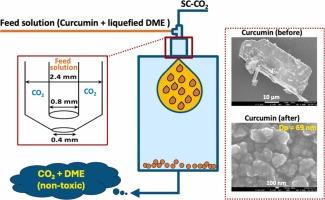Nanoparticulation of curcumin by liquefied dimethyl ether feed solution assisted supercritical carbon dioxide anti-solvent with coaxial nozzle
IF 4.4
3区 工程技术
Q2 CHEMISTRY, PHYSICAL
引用次数: 0
Abstract
Curcumin is a hydrophobic polyphenolic compound with various pharmacological effects. However, its poor water solubility and bioavailability limit its clinical application. In this study, curcumin nanoparticles were successfully prepared by the supercritical CO2 anti-solvent (SAS) technique using liquefied dimethyl ether (DME) as the solvent and a coaxial nozzle to promote particle formation. For comparison, curcumin particles were prepared under the same conditions using ethanol as the solvent. The effects of the process parameters, including pressure and temperature, were investigated on the curcumin nanoparticles. Field-emission scanning electron microscopy (FE-SEM) images showed that curcumin nanoparticles with a uniform spherical morphology and an average diameter of < 100 nm were obtained from liquefied DME at 10 MPa and 60 °C. In comparison, curcumin particles precipitated from ethanol at 14 MPa and 50 °C had a larger average size of > 100 nm and broader, less uniform particle size distribution. The smallest nanoparticles precipitated from liquefied DME required a lower pressure than those precipitated from ethanol. X-ray diffraction (XRD) analysis confirmed that the nanoparticles obtained from both liquefied DME and ethanol solutions had an amorphous structure, indicating complete transformation from the crystalline form of the original curcumin. Furthermore, Fourier-transform infrared (FT-IR) spectroscopy revealed no detectable residual solvent in the DME-precipitated nanoparticles, whereas the spectra of the ethanol-precipitated particles showed characteristic peaks corresponding to residual ethanol. This approach provides a promising strategy to improve the solubility and bioavailability of curcumin for pharmaceutical applications.

用同轴喷嘴液化二甲醚进料液辅助超临界二氧化碳抗溶剂制备姜黄素纳米颗粒
姜黄素是一种疏水多酚类化合物,具有多种药理作用。但其水溶性和生物利用度较差,限制了其临床应用。本研究采用超临界CO2抗溶剂(SAS)技术,以液化二甲醚(DME)为溶剂,采用同轴喷嘴促进颗粒形成,成功制备了姜黄素纳米颗粒。为了比较,在相同条件下,以乙醇为溶剂制备姜黄素颗粒。考察了压力、温度等工艺参数对姜黄素纳米颗粒的影响。场发射扫描电镜(FE-SEM)图像显示,在10 MPa和60℃条件下,从二甲醚液化得到的姜黄素纳米颗粒具有均匀的球形形貌,平均直径为<; 100 nm。相比之下,在14 MPa和50℃条件下从乙醇中析出的姜黄素颗粒平均粒径较大,为>; 100 nm,粒径分布较宽,不均匀。从液化二甲醚中析出的最小的纳米颗粒所需的压力比从乙醇中析出的小。x射线衍射(XRD)分析证实,从液化二甲醚和乙醇溶液中获得的纳米颗粒具有无定形结构,表明原始姜黄素的结晶形式完全转变。此外,傅里叶变换红外光谱(FT-IR)显示,二甲醚沉淀的纳米颗粒中没有检测到残留的溶剂,而乙醇沉淀的纳米颗粒的光谱显示出与残留乙醇对应的特征峰。该方法为提高姜黄素的溶解度和生物利用度提供了一种有前途的策略。
本文章由计算机程序翻译,如有差异,请以英文原文为准。
求助全文
约1分钟内获得全文
求助全文
来源期刊

Journal of Supercritical Fluids
工程技术-工程:化工
CiteScore
7.60
自引率
10.30%
发文量
236
审稿时长
56 days
期刊介绍:
The Journal of Supercritical Fluids is an international journal devoted to the fundamental and applied aspects of supercritical fluids and processes. Its aim is to provide a focused platform for academic and industrial researchers to report their findings and to have ready access to the advances in this rapidly growing field. Its coverage is multidisciplinary and includes both basic and applied topics.
Thermodynamics and phase equilibria, reaction kinetics and rate processes, thermal and transport properties, and all topics related to processing such as separations (extraction, fractionation, purification, chromatography) nucleation and impregnation are within the scope. Accounts of specific engineering applications such as those encountered in food, fuel, natural products, minerals, pharmaceuticals and polymer industries are included. Topics related to high pressure equipment design, analytical techniques, sensors, and process control methodologies are also within the scope of the journal.
 求助内容:
求助内容: 应助结果提醒方式:
应助结果提醒方式:


